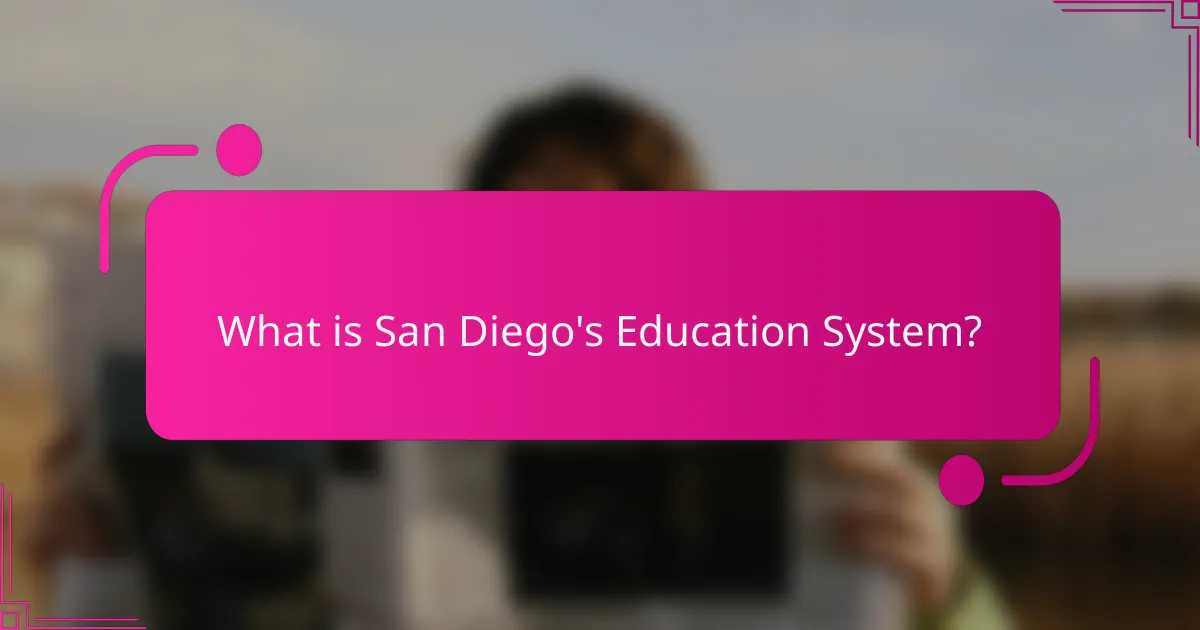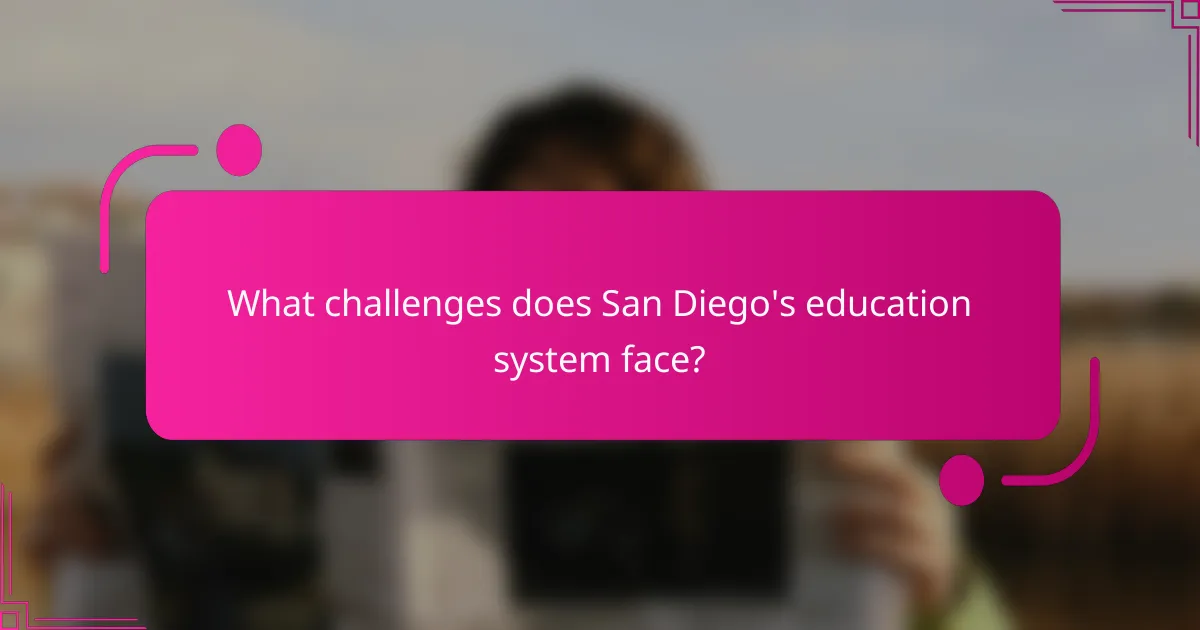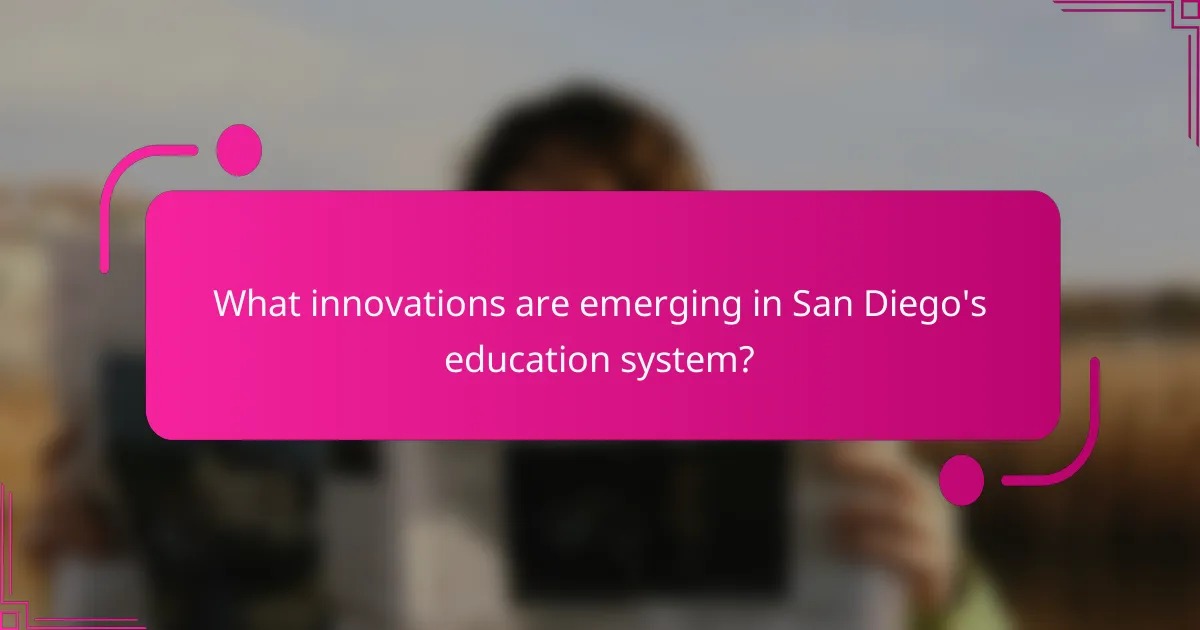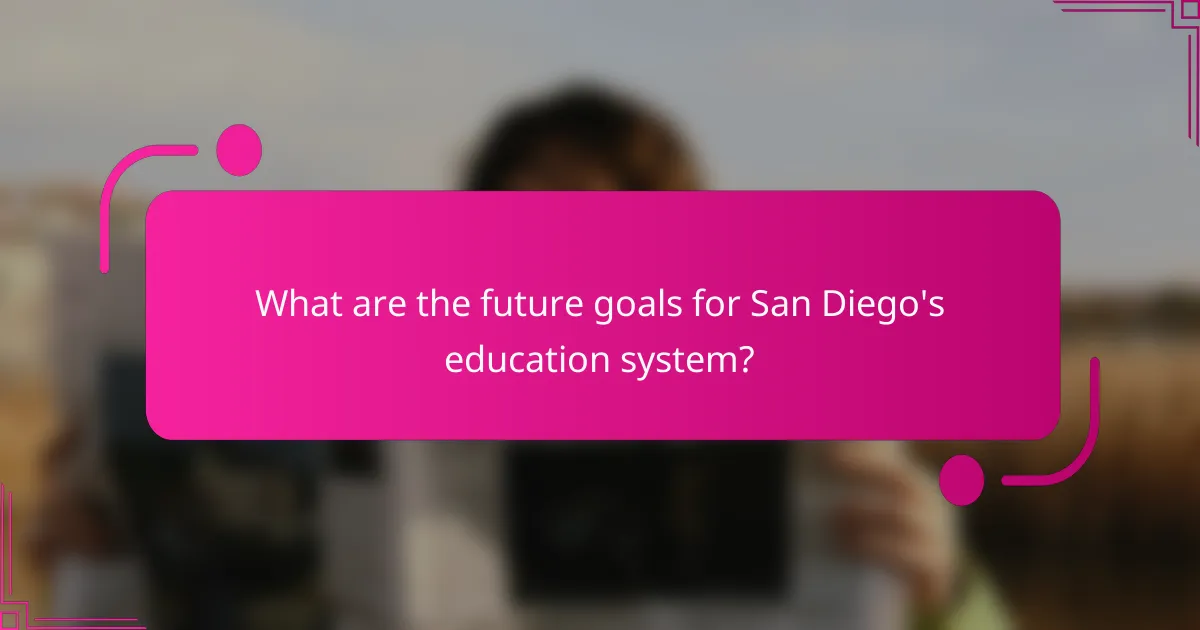
What is San Diego’s Education System?
San Diego’s education system is comprised of various public and private institutions serving K-12 students. The San Diego Unified School District is the largest school district in the area, overseeing numerous elementary, middle, and high schools. This district focuses on providing quality education and improving student outcomes. In addition to traditional public schools, the region has charter schools and private education options. San Diego’s education system also emphasizes STEM programs and arts integration. Recent initiatives aim to address achievement gaps and enhance educational equity. The district’s budget for the 2022-2023 school year was approximately $1.7 billion, reflecting its commitment to funding educational resources. Overall, San Diego’s education system is continually evolving to meet the needs of its diverse student population.
How is the education system structured in San Diego?
The education system in San Diego is structured primarily through public school districts and charter schools. The San Diego Unified School District is the largest district, serving over 100,000 students. It includes elementary, middle, and high schools, along with specialized programs and schools. Charter schools operate independently but are publicly funded, offering alternative educational approaches. Additionally, there are private schools that provide various curricula and educational philosophies. The California Department of Education oversees the standards and accountability for all schools in the region. This structure aims to address diverse educational needs and promote student achievement across the district.
What are the key components of San Diego’s education system?
The key components of San Diego’s education system include public schools, charter schools, and higher education institutions. Public schools serve the majority of students and are funded by local, state, and federal sources. Charter schools offer alternative educational options and operate independently of the traditional public school system. Higher education institutions, including universities and community colleges, provide advanced learning opportunities. The San Diego Unified School District oversees the largest portion of public education in the area. According to the California Department of Education, San Diego’s public schools serve over 130,000 students. Additionally, the city is home to several renowned universities, such as the University of California, San Diego.
How do these components interact within the system?
The components of San Diego’s education system interact through a collaborative framework. Schools, teachers, students, and parents engage in continuous communication. This interaction fosters a supportive learning environment. Local government and educational institutions provide funding and resources. Community organizations contribute additional support and programs. Data-driven assessments inform curriculum adjustments. Stakeholder feedback influences policy decisions. These interactions aim to address challenges and implement innovations effectively.
What are the historical developments that shaped San Diego’s education system?
San Diego’s education system has evolved through several key historical developments. The establishment of the first public school in 1854 marked the beginning of formal education in the area. In 1885, the San Diego City School District was formed, consolidating various local schools. The introduction of the 1910 school bond allowed for the construction of new school facilities, accommodating a growing population. During the 1960s, the desegregation movement led to significant changes in school policies and demographics. The establishment of community colleges in the 1970s expanded educational opportunities for residents. Recent reforms focus on addressing equity and access, responding to diverse student needs. Each of these developments has played a crucial role in shaping the current educational landscape in San Diego.
What major policies have influenced the education system over the years?
Major policies influencing the education system include the Elementary and Secondary Education Act (ESEA) of 1965 and the No Child Left Behind Act (NCLB) of 2001. ESEA aimed to close the achievement gap by providing federal funding to schools serving low-income students. NCLB emphasized standardized testing and accountability measures for schools. The Every Student Succeeds Act (ESSA) of 2015 replaced NCLB, giving states more control over education standards. Additionally, policies promoting inclusion and special education, such as the Individuals with Disabilities Education Act (IDEA), have shaped educational practices. These policies collectively address equity, accountability, and access in education.
How have demographic changes impacted the education landscape?
Demographic changes have significantly impacted the education landscape by altering student populations and their needs. For instance, increased diversity in San Diego has led to a greater demand for culturally responsive teaching methods. Enrollment figures show that Latino students now comprise the largest ethnic group in local schools. This shift necessitates curriculum adjustments to reflect diverse histories and perspectives. Additionally, changes in family structures have influenced educational support systems. More students come from single-parent or non-traditional families, requiring schools to provide additional resources. Furthermore, economic shifts have affected funding and resource allocation in schools. Areas with higher poverty rates often struggle to meet educational standards, impacting overall student achievement. These demographic trends are reshaping how educators approach teaching and learning in San Diego.

What challenges does San Diego’s education system face?
San Diego’s education system faces significant challenges, including funding disparities, overcrowded classrooms, and achievement gaps. Funding disparities arise from unequal resource distribution among schools. Many schools struggle to secure adequate funding, impacting educational quality. Overcrowded classrooms hinder personalized instruction and student engagement. This issue affects both teacher effectiveness and student learning outcomes. Achievement gaps persist between different demographic groups. These gaps highlight inequalities in access to quality education and resources. Additionally, mental health support for students remains insufficient. The lack of resources impacts students’ overall well-being and academic performance.
What are the primary challenges affecting student performance?
The primary challenges affecting student performance include socioeconomic factors, inadequate resources, and mental health issues. Socioeconomic factors such as poverty can limit access to educational support and materials. Inadequate resources, including insufficient funding for schools, impact the quality of education. Mental health issues, including anxiety and depression, can hinder student focus and engagement. Research shows that students from low-income families score lower on standardized tests. A study by the National Center for Education Statistics found that schools in high-poverty areas often lack essential educational tools. Additionally, the American Psychological Association highlights that mental health challenges significantly affect academic achievement.
How do socioeconomic factors contribute to educational disparities?
Socioeconomic factors significantly contribute to educational disparities. Students from low-income families often have limited access to quality educational resources. This includes fewer books, technology, and extracurricular activities. Schools in affluent areas typically receive more funding, leading to better facilities and programs. In contrast, underfunded schools struggle to provide essential services. Research shows that children in poverty are more likely to face challenges such as food insecurity and unstable housing. These issues can negatively impact their academic performance and engagement. Additionally, parental education levels often correlate with student success. Parents with higher education levels are more likely to support their children’s learning. Overall, socioeconomic status plays a crucial role in shaping educational outcomes.
What role does funding play in these challenges?
Funding significantly impacts the challenges faced by San Diego’s education system. Adequate funding is essential for maintaining facilities, hiring qualified teachers, and providing necessary resources. Limited financial resources can lead to larger class sizes and reduced program offerings. Insufficient funding often results in outdated technology and learning materials. Additionally, funding disparities can exacerbate inequities between schools in affluent areas and those in low-income neighborhoods. Research shows that increased investment in education correlates with improved student outcomes. For instance, the National Center for Education Statistics reports that schools with higher funding levels generally achieve better academic performance.
How does the education system address issues of equity and access?
The education system addresses issues of equity and access through various initiatives and policies. These include targeted funding for under-resourced schools. Programs aim to provide additional support for low-income students. Specialized services are offered for English language learners and students with disabilities. Community partnerships enhance resources and opportunities for all students. Data-driven approaches identify gaps in achievement and access. Professional development for educators focuses on culturally responsive teaching. Legislative measures promote equitable distribution of educational resources. These strategies collectively aim to create a more inclusive educational environment.
What programs are in place to support underrepresented students?
San Diego’s education system has various programs to support underrepresented students. These programs include mentorship initiatives, scholarship opportunities, and academic support services. The San Diego Unified School District offers the Equity and Access Program, which focuses on increasing access to quality education for marginalized groups. Additionally, organizations like the College Board provide resources for first-generation college students. The district also partners with community organizations to enhance support networks. These efforts aim to close achievement gaps and promote inclusivity in education.
How effective are these programs in achieving their goals?
The effectiveness of San Diego’s education programs in achieving their goals varies. Some programs show significant improvements in student performance and engagement. For instance, the implementation of technology in classrooms has led to a 15% increase in student test scores, according to the San Diego Unified School District’s annual report. Additionally, initiatives focused on social-emotional learning have resulted in a 20% decrease in student behavioral issues. However, challenges remain, particularly in addressing disparities among different student demographics. Programs targeting underserved communities have had mixed results, with some achieving their objectives while others struggle to make an impact. Overall, while many programs demonstrate effectiveness, ongoing evaluation and adaptation are essential for continued success.

What innovations are emerging in San Diego’s education system?
San Diego’s education system is witnessing several innovations aimed at enhancing learning experiences. The introduction of personalized learning models is one significant trend. These models tailor educational experiences to individual student needs. Additionally, the integration of technology in classrooms is rapidly evolving. Tools such as virtual reality and artificial intelligence are being utilized to engage students.
Another innovation is the emphasis on social-emotional learning. Schools are implementing programs to support students’ mental health and well-being. Furthermore, partnerships with local businesses are fostering real-world learning opportunities. These collaborations provide students with internships and hands-on experiences.
The use of data analytics is also emerging as a key innovation. Educators are leveraging data to track student progress and inform instructional strategies. Finally, there is a growing focus on STEAM (Science, Technology, Engineering, Arts, and Mathematics) education. This interdisciplinary approach encourages creativity and critical thinking among students.
What new teaching methods are being implemented in classrooms?
New teaching methods being implemented in classrooms include blended learning, project-based learning, and flipped classrooms. Blended learning combines traditional face-to-face instruction with online resources. Project-based learning engages students in real-world projects to develop critical thinking skills. Flipped classrooms allow students to learn new content at home and apply knowledge in class. These methods promote student engagement and personalized learning. Research shows that these approaches can improve student outcomes significantly. For instance, a study by the Bill & Melinda Gates Foundation found that blended learning can lead to higher academic performance in math and reading.
How are technology and digital tools transforming education?
Technology and digital tools are transforming education by enhancing accessibility and personalizing learning experiences. Online platforms allow students to access resources anytime and anywhere. This flexibility supports diverse learning styles and paces. Digital tools facilitate interactive learning through multimedia content. Virtual classrooms enable real-time collaboration among students and teachers. Data analytics provide insights into student performance, allowing tailored interventions. According to a report by the U.S. Department of Education, technology integration can improve student engagement and achievement. The shift towards blended learning models is evident in many San Diego schools, reflecting these trends.
What role do community partnerships play in educational innovation?
Community partnerships play a crucial role in educational innovation by enhancing resources and support for schools. They provide access to funding, expertise, and real-world experiences that enrich the curriculum. Partnerships with local businesses and organizations can lead to internships and mentorship opportunities for students. Research shows that schools engaged with community partners often see improved student engagement and achievement. For instance, a study by the Stanford Center for Opportunity Policy in Education found that collaborative initiatives boost learning outcomes. These partnerships also foster a sense of shared responsibility for education within the community. Engaging families and local stakeholders creates a more supportive environment for innovation. Overall, community partnerships are essential for driving meaningful changes in educational practices.
How are schools adapting to the needs of 21st-century learners?
Schools are adapting to the needs of 21st-century learners by integrating technology into the curriculum. They are utilizing digital tools to enhance learning experiences. Many schools are adopting blended learning models that combine online and in-person instruction. This approach allows for personalized learning paths tailored to individual student needs. Additionally, schools are emphasizing critical thinking and collaboration skills. They are redesigning classrooms to promote interactive and flexible learning environments. Professional development for teachers is also a focus to equip them with modern teaching strategies. According to a 2021 report by the U.S. Department of Education, 78% of teachers reported using technology to support student learning. This data highlights the shift towards a more tech-savvy educational landscape.
What skills are prioritized in the curriculum?
The skills prioritized in the curriculum include critical thinking, collaboration, and communication. These skills are essential for preparing students for the modern workforce. Critical thinking enables students to analyze information and solve complex problems. Collaboration fosters teamwork and interpersonal skills necessary for group projects. Communication skills are vital for effective expression of ideas and information. According to the California Department of Education, these skills align with the 21st-century learning framework. This framework emphasizes the importance of preparing students for a rapidly changing global economy.
How are educators trained to implement these innovations?
Educators are trained to implement innovations through professional development programs. These programs focus on practical strategies and techniques. Workshops and seminars are commonly used formats. Educators receive hands-on training to apply new methods in classrooms. Collaborative learning environments foster peer-to-peer support. Ongoing coaching and mentorship enhance implementation efforts. Research indicates that sustained professional development leads to improved teaching practices. A study by the National Staff Development Council highlights the effectiveness of such training in enhancing educator skills.

What are the future goals for San Diego’s education system?
The future goals for San Diego’s education system include improving educational equity and increasing access to quality education. The district aims to ensure all students, regardless of background, have equal opportunities to succeed. Another goal is to enhance STEM education to prepare students for future job markets. Additionally, there is a focus on integrating social-emotional learning into the curriculum. The district also plans to expand community partnerships to support student learning. Improving teacher recruitment and retention is a priority to ensure high-quality instruction. Finally, the district seeks to increase funding for resources and facilities to create better learning environments. These goals align with the district’s commitment to fostering a comprehensive and inclusive educational experience.
What initiatives are being proposed to improve educational outcomes?
Proposed initiatives to improve educational outcomes in San Diego include increased funding for schools and enhanced teacher training programs. These initiatives aim to address resource disparities and improve instructional quality. The San Diego Unified School District has outlined a plan to allocate additional resources to underfunded schools. Research indicates that schools with better funding show improved student performance. Furthermore, initiatives include implementing technology in classrooms to facilitate personalized learning. Evidence suggests that technology integration can enhance student engagement and achievement. Additionally, partnerships with local organizations aim to provide mentorship and support services for students. These collaborative efforts seek to create a more supportive educational environment.
How do these initiatives aim to address existing challenges?
These initiatives aim to address existing challenges by implementing targeted educational reforms. They focus on improving student engagement and academic performance. Strategies include enhancing teacher training and resources. Additionally, initiatives promote technology integration in classrooms. They also foster community partnerships to support student needs. Data-driven approaches identify at-risk students for timely intervention. These efforts align with national educational standards and best practices. Evidence from similar initiatives shows improved outcomes in student achievement.
What timelines are set for achieving these goals?
The timelines set for achieving goals in San Diego’s education system typically span from one to five years. Short-term goals are often targeted for completion within one academic year. Medium-term goals may extend over a three-year period. Long-term goals generally aim for completion within five years. These timelines are established to ensure measurable progress and accountability. Each goal is aligned with specific benchmarks to track advancement. The San Diego Unified School District outlines these timelines in its strategic plan. Regular assessments are conducted to evaluate progress against these timelines.
How can community involvement shape the future of education in San Diego?
Community involvement can significantly shape the future of education in San Diego. Engaged communities can advocate for better resources and funding for schools. Local businesses can partner with schools to provide internships and mentorship programs. Parents and community members can participate in school boards, influencing policy decisions. Research shows that schools with strong community ties often see improved student performance and engagement. For example, a study by the National Education Association highlights that community involvement leads to higher graduation rates. Collaborative efforts can also address specific local educational challenges, fostering innovation in teaching methods. Overall, active community participation creates a supportive environment for students and educators alike.
What role do parents and local organizations play in educational reform?
Parents and local organizations play a crucial role in educational reform. They advocate for changes that improve student outcomes. Parents often participate in school boards and committees. Their involvement ensures that community needs are addressed. Local organizations provide resources and support for educational initiatives. They can offer funding, mentorship, and volunteers. Research shows that parental involvement increases student achievement. A study by the National Education Association found that engaged parents lead to higher graduation rates. This collaboration fosters a sense of community ownership in schools. Together, parents and organizations drive meaningful change in education.
How can stakeholders collaborate to support the education system?
Stakeholders can collaborate to support the education system by forming partnerships that enhance resources and opportunities. Schools, parents, and community organizations can unite to create programs that address specific educational needs. For instance, local businesses can provide internships or mentorships to students, fostering real-world experience. Nonprofits can offer tutoring and enrichment programs to assist struggling students. Additionally, government agencies can allocate funding for educational initiatives, ensuring schools have necessary materials and support. Research shows that collaborative efforts improve student outcomes, as seen in the “Partnerships for Student Success” study by the Institute for Educational Leadership, which found that integrated support systems lead to higher graduation rates.
What best practices can be adopted to enhance San Diego’s education system?
Implementing personalized learning can significantly enhance San Diego’s education system. Personalized learning tailors education to meet individual student needs. This approach can improve student engagement and academic performance. Research shows that personalized learning increases achievement by 30%. Integrating technology in classrooms supports this method. Tools like adaptive learning software can provide customized resources. Professional development for teachers is essential for effective implementation. Training educators on personalized strategies enhances their teaching methods. Community involvement also plays a crucial role. Engaging parents and local organizations fosters a supportive learning environment. These best practices can collectively lead to a more effective education system in San Diego.
San Diego’s education system encompasses a diverse range of public and private institutions, primarily led by the San Diego Unified School District. This overview addresses the system’s structure, key components, and historical developments, alongside the challenges it faces, such as funding disparities and achievement gaps. Innovations in teaching methods and technology integration are highlighted, along with future goals aimed at improving educational equity and access. The article also discusses the role of community involvement and best practices that can enhance the overall effectiveness of education in San Diego.